Abstract
1. In cats anaesthetized with a mixture of chloralose and urethane, stimulation of pulmonary C fibres by right atrial injections of phenylbiguanide caused, after a latency of about 3 s, a reduction in pulmonary ventilation or apnoea, bradycardia and systemic hypotension, confirming previous work. 2. A decrease in femoral artery perfusion pressure also occurred under conditions in which the hindlimb was vascularly isolated, the blood flow was maintained constant and the inferior vena caval pressure did not change. This indicates a reduction in vascular resistance due to vasodilatation. The response was unaffected by atropine and propranolol, but was reduced or abolished by guanethidine, hexamethonium and denervation of the limb, indicating that it is due to a reduction in activity in sympathetic vasoconstrictor fibres. 3. Similar cardiovascular responses were observed when the arterial blood pressure was maintained constant, and also in artificially ventilated animals. 4. Evidence is presented that the receptors responsible for the respiratory and cardiovascular responses to right atrial injections of phenylbiguanide lie in the pulmonary vascular bed. 5. When the pulmonary C fibres were excited during a period of apnoea which was induced reflexly by electrical stimulation of the central end of a superior laryngeal nerve, there were no consistent differences in the size of the cardiac or vascular responses compared to the control responses in the absence of the laryngeal input. This result occurred irrespective of the size of the control ventilatory response to phenylbiguanide. 6. By contrast in the same experiments, the cardio-inhibitory and vasoconstrictor responses to excitation of the carotid body chemoreceptors were invariably potentiated by electrical stimulation of a superior laryngeal nerve, as found previously. 7. The possible central mechanisms responsible for the differential modulation of pulmonary C fibre and carotid chemoreceptor reflexes by respiration are discussed.
Full text
PDF
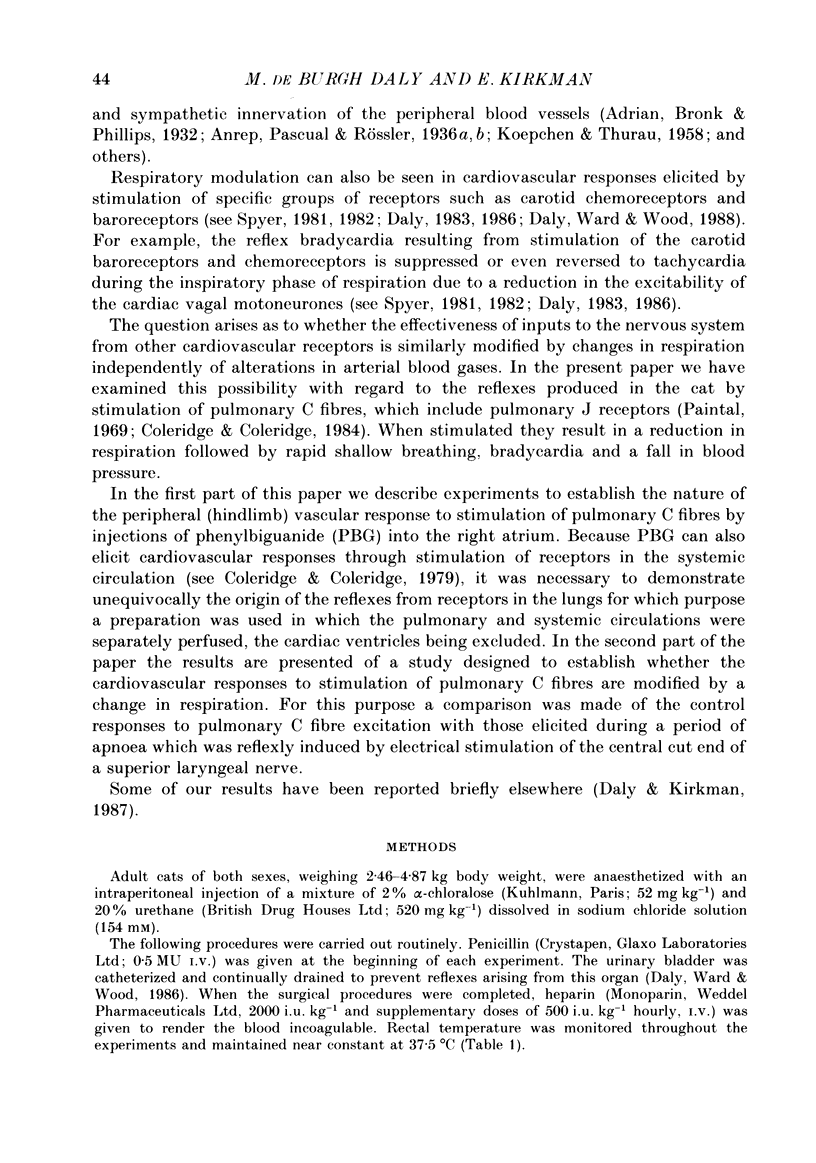


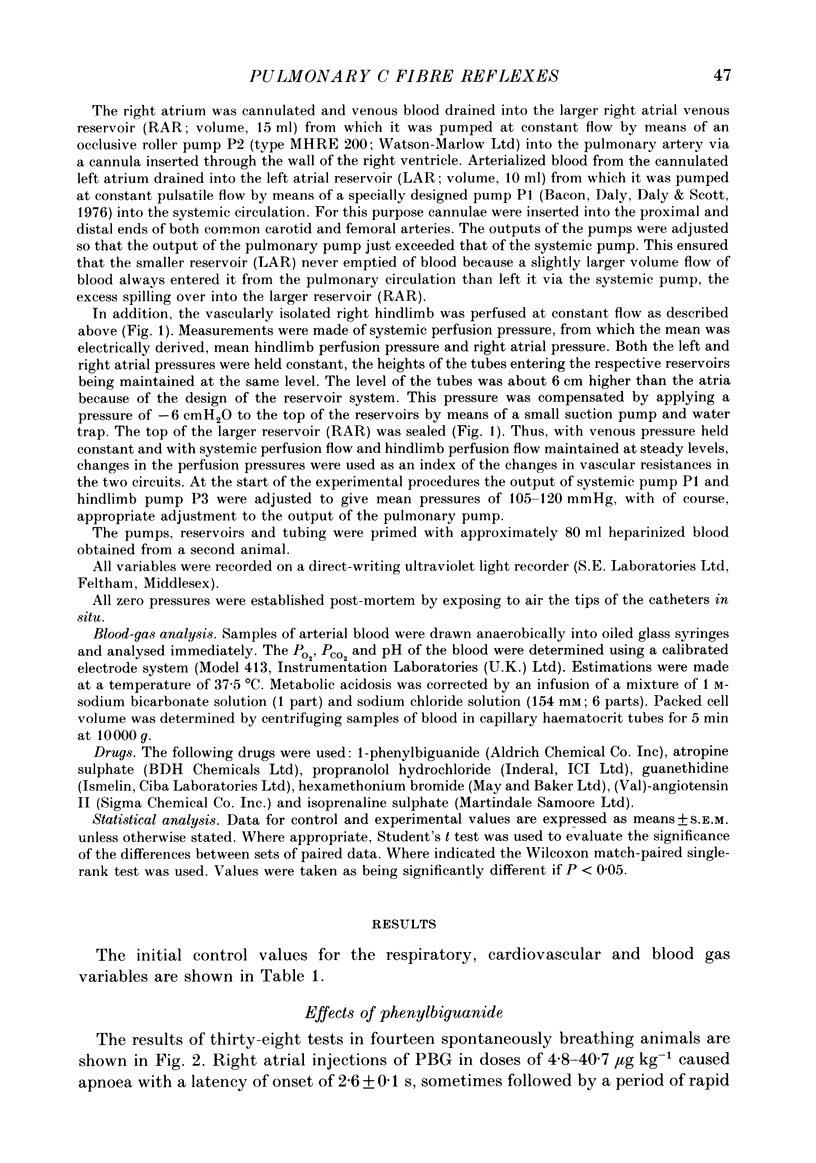

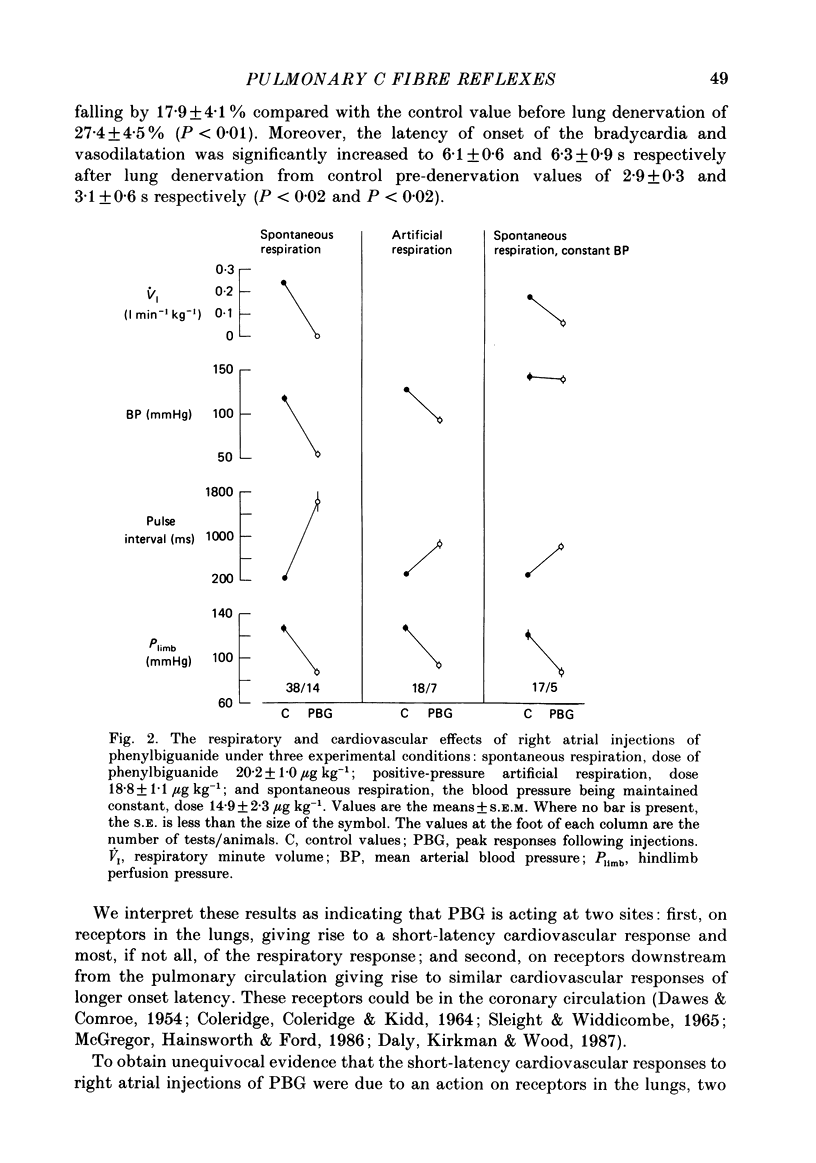


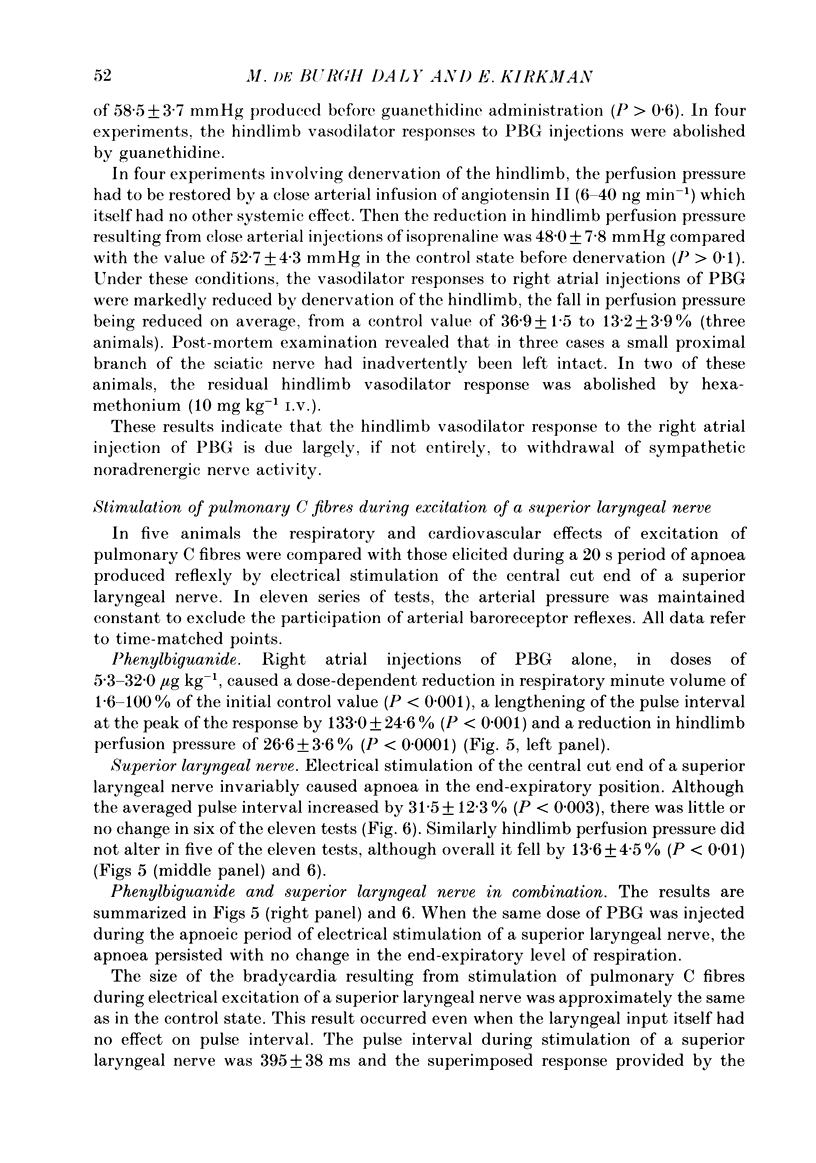
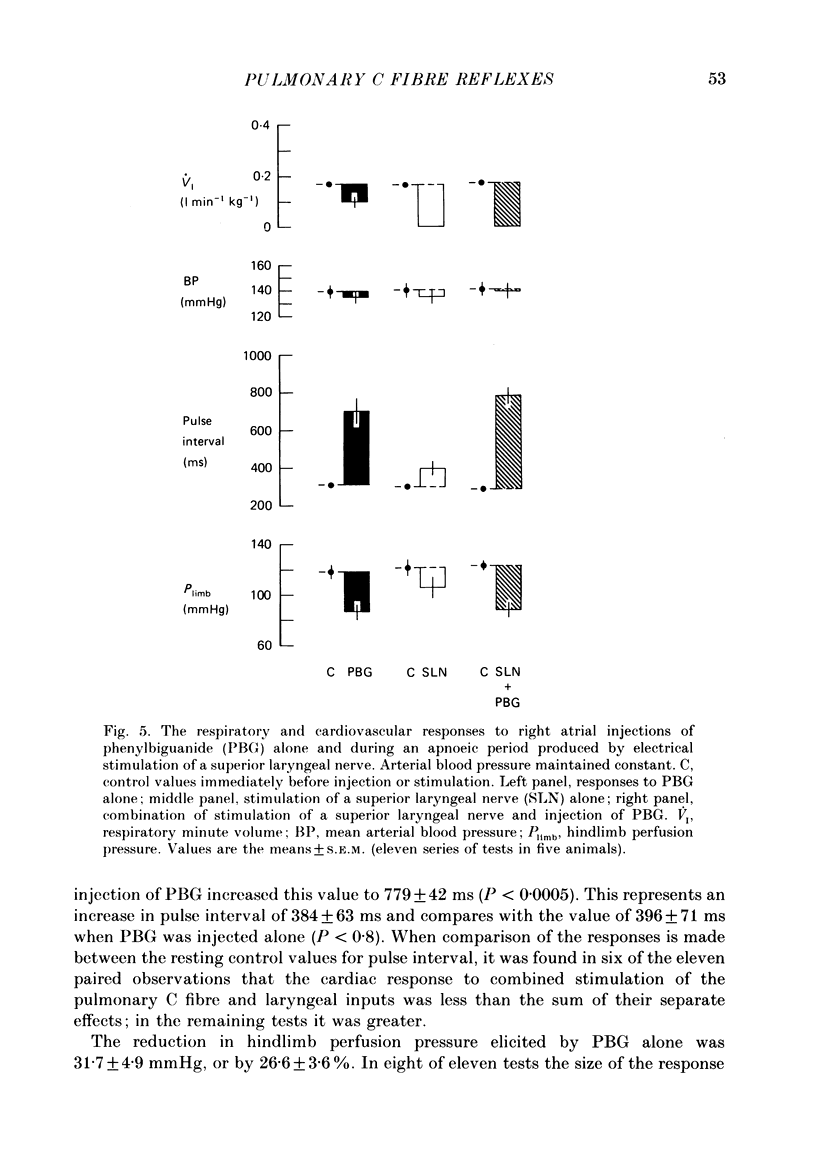






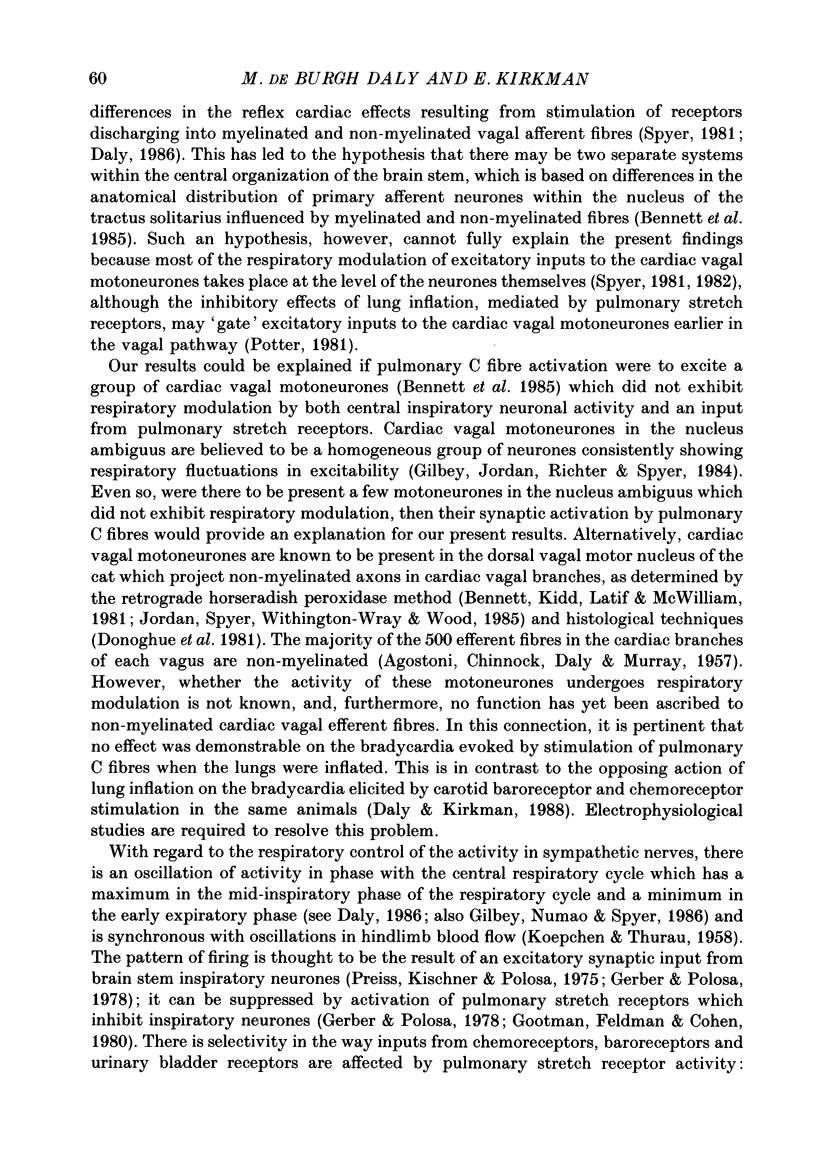



Selected References
These references are in PubMed. This may not be the complete list of references from this article.
- AGOSTONI E., CHINNOCK J. E., DE DALY M. B., MURRAY J. G. Functional and histological studies of the vagus nerve and its branches to the heart, lungs and abdominal viscera in the cat. J Physiol. 1957 Jan 23;135(1):182–205. doi: 10.1113/jphysiol.1957.sp005703. [DOI] [PMC free article] [PubMed] [Google Scholar]
- Adrian E. D., Bronk D. W., Phillips G. Discharges in mammalian sympathetic nerves. J Physiol. 1932 Feb 8;74(2):115–133. doi: 10.1113/jphysiol.1932.sp002832. [DOI] [PMC free article] [PubMed] [Google Scholar]
- Angell-James J. E., Daly M. B. Some aspects of upper respiratory tract reflexes. Acta Otolaryngol. 1975 Mar-Apr;79(3-4):242–252. doi: 10.3109/00016487509124680. [DOI] [PubMed] [Google Scholar]
- Angell-James J. E., Daly M. D. The effects of artificial lung inflation on reflexly induced bradycardia associated with apnoea in the dog. J Physiol. 1978 Jan;274:349–366. doi: 10.1113/jphysiol.1978.sp012152. [DOI] [PMC free article] [PubMed] [Google Scholar]
- Angell-James J. E., Daly M. de B. The interaction of reflexes elicited by stimulation of carotid body chemoreceptors and receptors in the nasal mucosa affecting respiration and pulse interval in the dog. J Physiol. 1973 Feb;229(1):133–149. doi: 10.1113/jphysiol.1973.sp010131. [DOI] [PMC free article] [PubMed] [Google Scholar]
- Bacon D. R., Daly C DE B., Daly M. de B., Scott R. W. Midified roller pump with improved haemodynamic characteristics and temperature control of perfusate. Lab Pract. 1976 Jul;25(7):464–466. [PubMed] [Google Scholar]
- Bennett J. A., Goodchild C. S., Kidd C., McWilliam P. N. Neurones in the brain stem of the cat excited by vagal afferent fibres from the heart and lungs. J Physiol. 1985 Dec;369:1–15. doi: 10.1113/jphysiol.1985.sp015884. [DOI] [PMC free article] [PubMed] [Google Scholar]
- Bennett J. A., Kidd C., Latif A. B., McWilliam P. N. A horseradish peroxidase study of vagal motoneurones with axons in cardiac and pulmonary branches of the cat and dog. Q J Exp Physiol. 1981 Apr;66(2):145–154. doi: 10.1113/expphysiol.1981.sp002541. [DOI] [PubMed] [Google Scholar]
- Brender D., Webb-Peploe M. M. Vascular responses to stimulation of pulmonary and carotid baroreceptors by capsaicin. Am J Physiol. 1969 Dec;217(6):1837–1845. doi: 10.1152/ajplegacy.1969.217.6.1837. [DOI] [PubMed] [Google Scholar]
- COLERIDGE H. M., COLERIDGE J. C., KIDD C. CARDIAC RECEPTORS IN THE DOG, WITH PARTICULAR REFERENCE TO TWO TYPES OF AFFERENT ENDING IN THE VENTRICULAR WALL. J Physiol. 1964 Nov;174:323–339. doi: 10.1113/jphysiol.1964.sp007490. [DOI] [PMC free article] [PubMed] [Google Scholar]
- Cassidy S. S., Ashton J. H., Wead W. B., Kaufman M. P., Monsereenusorn Y., Whiteside J. A. Reflex cardiovascular responses caused by stimulation of pulmonary C-fibers with capsaicin in dogs. J Appl Physiol (1985) 1986 Mar;60(3):949–958. doi: 10.1152/jappl.1986.60.3.949. [DOI] [PubMed] [Google Scholar]
- Coleman H. A., Parkington H. C. Induction of prolonged excitability in myometrium of pregnant guinea-pigs by prostaglandin F2 alpha. J Physiol. 1988 May;399:33–47. doi: 10.1113/jphysiol.1988.sp017066. [DOI] [PMC free article] [PubMed] [Google Scholar]
- Coleridge J. C., Coleridge H. M. Afferent vagal C fibre innervation of the lungs and airways and its functional significance. Rev Physiol Biochem Pharmacol. 1984;99:1–110. doi: 10.1007/BFb0027715. [DOI] [PubMed] [Google Scholar]
- DAWES G. S., COMROE J. H., Jr Chemoreflexes from the heart and lungs. Physiol Rev. 1954 Apr;34(2):167–201. doi: 10.1152/physrev.1954.34.2.167. [DOI] [PubMed] [Google Scholar]
- DE DALY M. B., SCOTT M. J. The effects of stimulation of the carotid body chemoreceptors on heart rate in the dog. J Physiol. 1958 Nov 10;144(1):148–166. doi: 10.1113/jphysiol.1958.sp006092. [DOI] [PMC free article] [PubMed] [Google Scholar]
- Daly M. B., Korner P. I., Angell-James J. E., Oliver J. R. Cardiovascular-respiratory reflex interactions between carotid bodies and upper-airways receptors in the monkey. Am J Physiol. 1978 Mar;234(3):H293–H299. doi: 10.1152/ajpheart.1978.234.3.H293. [DOI] [PubMed] [Google Scholar]
- Daly M. D., Ward J., Wood L. M. Modification by lung inflation of the vascular responses from the carotid body chemoreceptors and other receptors in dogs. J Physiol. 1986 Sep;378:13–30. doi: 10.1113/jphysiol.1986.sp016205. [DOI] [PMC free article] [PubMed] [Google Scholar]
- Daly M., Ungar A. Comparison of the reflex responses elicited by stimulation of the separately perfused carotid and aortic body chemoreceptors in the dog. J Physiol. 1966 Jan;182(2):379–403. doi: 10.1113/jphysiol.1966.sp007828. [DOI] [PMC free article] [PubMed] [Google Scholar]
- Donoghue S., Fox R. E., Kidd C., Koley B. N. The distribution in the cat brain stem of neurones activated by vagal nonmyelinated fibres from the heart and lungs. Q J Exp Physiol. 1981 Oct;66(4):391–404. doi: 10.1113/expphysiol.1981.sp002582. [DOI] [PubMed] [Google Scholar]
- Elsner R., Angell-James J. E., de Burgh Daly M. Carotid body chemoreceptor reflexes and their interactions in the seal. Am J Physiol. 1977 May;232(5):H517–H525. doi: 10.1152/ajpheart.1977.232.5.H517. [DOI] [PubMed] [Google Scholar]
- Gandevia S. C., McCloskey D. I., Potter E. K. Inhibition of baroreceptor and chemoreceptor reflexes on heart rate by afferents from the lungs. J Physiol. 1978 Mar;276:369–381. doi: 10.1113/jphysiol.1978.sp012240. [DOI] [PMC free article] [PubMed] [Google Scholar]
- Gerber U., Polosa C. Effects of pulmonary stretch receptor afferent stimulation on sympathetic preganglionic neuron firing. Can J Physiol Pharmacol. 1978 Apr;56(2):191–198. doi: 10.1139/y78-027. [DOI] [PubMed] [Google Scholar]
- Gilbey M. P., Jordan D., Richter D. W., Spyer K. M. Synaptic mechanisms involved in the inspiratory modulation of vagal cardio-inhibitory neurones in the cat. J Physiol. 1984 Nov;356:65–78. doi: 10.1113/jphysiol.1984.sp015453. [DOI] [PMC free article] [PubMed] [Google Scholar]
- Gilbey M. P., Numao Y., Spyer K. M. Discharge patterns of cervical sympathetic preganglionic neurones related to central respiratory drive in the rat. J Physiol. 1986 Sep;378:253–265. doi: 10.1113/jphysiol.1986.sp016218. [DOI] [PMC free article] [PubMed] [Google Scholar]
- KOEPCHEN H. P., THURAU K. Untersuchungen über Zusammenhänge zwischen Blutdruckwellen und Ateminnervation. Pflugers Arch. 1958;267(1):10–26. doi: 10.1007/BF00362243. [DOI] [PubMed] [Google Scholar]
- KOEPCHEN H. P., WAGNER P. H., LUX H. D. [On the relationships between central excitation, reflex tone and respiratory rhythm in nervous regulation of heart frequency]. Pflugers Arch Gesamte Physiol Menschen Tiere. 1961;273:443–465. [PubMed] [Google Scholar]
- Kalia M., Mesulam M. M. Brain stem projections of sensory and motor components of the vagus complex in the cat: II. Laryngeal, tracheobronchial, pulmonary, cardiac, and gastrointestinal branches. J Comp Neurol. 1980 Sep 15;193(2):467–508. doi: 10.1002/cne.901930211. [DOI] [PubMed] [Google Scholar]
- MACLEOD R. D., SCOTT M. J. THE HEART RATE RESPONSES TO CAROTID BODY CHEMORECEPTOR STIMULATION IN THE CAT. J Physiol. 1964 Dec;175:193–202. doi: 10.1113/jphysiol.1964.sp007511. [DOI] [PMC free article] [PubMed] [Google Scholar]
- McAllen R. M., Spyer K. M. The baroreceptor input to cardiac vagal motoneurones. J Physiol. 1978 Sep;282:365–374. doi: 10.1113/jphysiol.1978.sp012469. [DOI] [PMC free article] [PubMed] [Google Scholar]
- McGregor K. H., Hainsworth R., Ford R. Hind-limb vascular responses in anaesthetized dogs to aortic root injections of veratridine. Q J Exp Physiol. 1986 Oct;71(4):577–587. doi: 10.1113/expphysiol.1986.sp003018. [DOI] [PubMed] [Google Scholar]
- Paintal A. S. Mechanism of stimulation of type J pulmonary receptors. J Physiol. 1969 Aug;203(3):511–532. doi: 10.1113/jphysiol.1969.sp008877. [DOI] [PMC free article] [PubMed] [Google Scholar]
- Potter E. K. Inspiratory inhibition of vagal responses to baroreceptor and chemoreceptor stimuli in the dog. J Physiol. 1981 Jul;316:177–190. doi: 10.1113/jphysiol.1981.sp013781. [DOI] [PMC free article] [PubMed] [Google Scholar]
- Preiss G., Kirchner F., Polosa C. Patterning of sympathetic preganglionic neuron firing by the central respiratory drive. Brain Res. 1975 Apr 11;87(2-3):363–374. doi: 10.1016/0006-8993(75)90434-5. [DOI] [PubMed] [Google Scholar]
- Sleight P., Widdicombe J. G. Action potentials in fibres from receptors in the epicardium and myocardium of the dog's left ventricle. J Physiol. 1965 Nov;181(2):235–258. doi: 10.1113/jphysiol.1965.sp007758. [DOI] [PMC free article] [PubMed] [Google Scholar]
- Spyer K. M. Central nervous integration of cardiovascular control. J Exp Biol. 1982 Oct;100:109–128. doi: 10.1242/jeb.100.1.109. [DOI] [PubMed] [Google Scholar]
- Spyer K. M. Neural organisation and control of the baroreceptor reflex. Rev Physiol Biochem Pharmacol. 1981;88:24–124. [PubMed] [Google Scholar]


